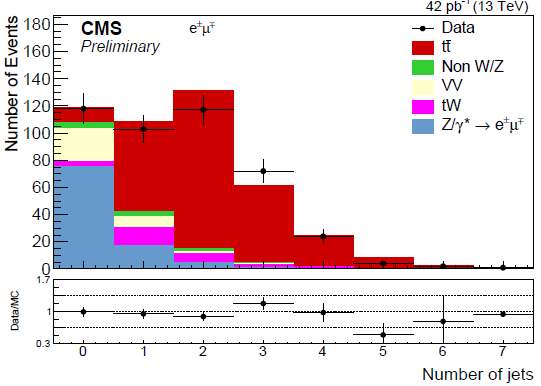The top quark is quite special, in fact. With a mass of 173 GeV, it is the heaviest corpuscle which we still describe as structureless and point-like. 173 GeV correspond to the weight of a heavy nucleus made of 180 or so protons and neutrons, so you well understand how conceptually surprising it is to think that the top is an elementary particle. But as far as we know, it is.
Top quarks are quite unlike the other quarks for another reason. Their large mass makes them decay at an incredibly fast rate, so fast in fact that even the subatomic reactions and interactions that usually bind quarks together into stable hadrons cannot involve them. While we can study, e.g., the next-heaviest quark, the bottom, by examining the properties of hadrons that contain bottom quarks, this is not possible with the top: it lives and decays as a free body, as if quantum chromodynamics did not exist during that fantastically short time - a millionth of a billionth of a billionth of a second.
That said, the reason why we continue to be very interested in the properties of the top quark 20 years after its discovery is a different one. There are a number of new physics theories that predict a special role of the top quark; new heavy particles may, for instance, couple preferentially to the heaviest quark in the lot, so by looking for top quarks one might stumble in events due to the production and decay of those new particles. Also, the detailed properties of the top have a significant role in determining the characteristics of several new physics theories - the most notable example being supersymmetry. Hence we want to keep measuring the top quark mass, production rate, and branching fractions with precision.
It goes without saying then that looking for top quark production in the higher-energy collisions that the LHC has started to produce this summer is interesting to us: at the higher energy, the LHC might be producing new particles, and these might manifest in enhanced production of top quarks. Then, there is another more technical reason for studying top production with the first new data we collect: the events featuring the decay of top quark pairs (the most common production process involves a top-antitop pair) are very rich with rare objects - electrons and muons, neutrinos leaving missing energy in the detector, and b-quark jets - which we need to tune our detectors on.
CMS has used the very first 42 inverse picobarns of 13-TeV proton-proton collisions this summer to measure the rate of production of top quark pairs. This rate is a number which theory predicts with significant accuracy, so a comparison of estimate and expectation is a meaningful scientific test.
In order to obtain a precise measurement, CMS used decays in the electron-muon "dilepton" category: one top quark must have decayed into an electron, the corresponding neutrino, and a b-quark jet; and the other to a muon, neutrino, and b-jet. Since the leptonic decay occurs only about 11% of the time for each top, in total only 2% of the top pairs end up in this special category (there is a factor of 2 from combinatorics, as both eμ and μe final states are used). This means that 98% of the produced top pairs are not used; but the used ones are the cleanest ones, the ones least ridden by background mimicking the same signature. And less background means a more precise result.

In the figure above you can see one sample distribution of the data (shown as black points with uncertainty bars): it is the number of jets counted in top pair candidate events. Data with fewer than two jets, populating the leftmost two bins, are not used for the cross section measurement, as they contain some background; while the data with at least two jets are very clean; the red histogram is the expected top contribution of the data. The lower part of the graph shows the ratio of measured data and theory prediction, which is close to 1 as expected.
The resulting measurement of the top production rate is shown in the graph below, as a function of centre-of-mass energy of the collision. It is the rightmost bullet, in red, on the top part of the graph, right on top of the green curve.

In the figure, there are two theory curves, describing the production rate of top quark pairs as a function of centre-of-mass energy for proton-proton and proton-antiproton collisions in green and cyan, respectively. It is slightly more probable to produce top pairs if you collide protons with antiprotons, but the Tevatron - the machine which discovered the top, and which populated this graph with the star at the lower left - is now decommissioned. The higher-energy frontier is going to be studied with proton-proton collisions only, from now on.
Earlier measurements done by the LHC experiments at lower energy found a smaller production rate, which is totally expected as top quarks are heavy and so they are hard to produce if you do not produce enough energy in the collisions. The result is in very good match with theory, so for now all we can say is that CMS is back in business and that there seem to be nothing weird going on at 13 TeV... But this is just the first of a number of new results which we expect to publish in the forthcoming weeks.





Comments